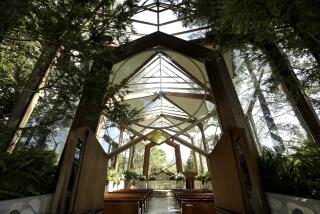Neighbors Assail Plan to Move Historic Lighthouse
- Share via
BUXTON, N.C. — At night, the beam from the Cape Hatteras lighthouse reflects off a window in Beatrice McArthur’s bungalow, reminding her of the ancestors who once owned the land on which it sits.
“I feel like it’s my friend. I’m very sentimental about my lighthouse,” says the soft-spoken woman whose family tree includes many keepers of the Hatteras light and others on the Atlantic coast.
Nine generations ago, her ancestors sold four acres to the government for $50 for construction of the lighthouse, she said, producing a copy of the handwritten deed in her needlepoint-decorated living room. In the adjoining dining room is a model of the black-and-white swirled lighthouse.
But now her “friend”--at 198 feet the tallest lighthouse in the country--is scheduled to be moved about half a mile, in an extraordinary feat of engineering.
Erosion has left the brick structure just 120 feet from the crashing surf, and supporters say the move from its present shallow foundation is necessary to protect it.
McArthur worries that it will not survive the trip because two cracks run the length of the tower.
Advocates say the move is little different from moving the space shuttle, an argument she counters by saying, “The rocket isn’t old. It isn’t built of bricks and mortar.”
Congress approved $10 million for the National Park Service to plan and carry out the move, tentatively scheduled to be completed by June. Crews from International Chimney Corp. of Buffalo, N.Y., will dig out the tower’s stone and wood foundation, jack up the structure and slowly move it along rails to the new site.
When the move is complete, the lighthouse will be 1,600 feet from the sea, just as it was when it was built in 1870 and before erosion took its toll.
The move can be done safely, said Rob Bolling, lighthouse historian for the Cape Hatteras National Seashore. Leaving the structure where it is and building sand-catching jetties to build up beach, he said, would cost more in the long run than the move.
Bolling, sitting on a bench at the whitewashed keeper’s house beside the lighthouse, said some local folks have told him they’re pleased to know something is being done.
“Of course, they say, ‘I wouldn’t want to say these things in town,’ ” Bolling said.
When asked, many locals voice worries similar to McArthur’s, and some say that, even if successful, the move will compromise the Hatteras light’s historical significance.
Public meetings on the subject have been dominated by opponents asking why it is necessary.
Edgar Hooper said he can see the light’s twin beams flash every night before he goes to sleep.
“It’s always been there,” says the 83-year-old Hooper, founder of the Lighthouse View Motel, now run by his son. “I think they’re a darned fool to try to move it. . . . I don’t like wasting my tax dollars when it can be done otherwise.”
Hooper points to a proposal, reviewed by the Army Corps of Engineers, to build up the shoreline by repairing three existing groins and adding a fourth. Bolling said the Park Service had never considered that as a permanent solution.
The move has been challenged with a federal lawsuit filed by the Dare County Board of Commissioners. The villagers say the lawsuit is their last hope. In January, the lighthouse grounds were fenced to create a construction zone.
Today, the lighthouse controversy evokes bitter memories from some older Hatteras Island residents who recall when the Park Service bought land cheaply decades ago for the seashore.
“With daddy’s generation, the Park Service came in and said, ‘We’re taking your land,’ and they’ve held a grudge,” said John Hooper, Edgar Hooper’s son and chairman of a committee that fought the move. “Certainly, this has fueled more hard feelings.”
Still, said McArthur, without the Park Service “this place would be like Myrtle Beach,” the highly developed resort town down the coast in South Carolina.
The lighthouse has always been a gathering place and a point of pride for townspeople.
Danny Couch recalls a basketball coach at Cape Hatteras School here who made the team run to the lighthouse, then up and down its steel steps, twice.
“We were in shape,” says the 38-year-old auto mechanic, grinning. Turning serious, he relates how the light saved hundreds of ships from wrecking on shoals.
John Hooper and McArthur also have fond memories. He recalls the lighthouse as a nightly meeting place for teenagers when he was young. She remembers as a girl--”15 and foolish”--walking around the ledge at its base high off the ground.
“We get asinine comments about being too sentimental about it,” she said. “I don’t apologize for being sentimental.”
More to Read
Sign up for The Wild
We’ll help you find the best places to hike, bike and run, as well as the perfect silent spots for meditation and yoga.
You may occasionally receive promotional content from the Los Angeles Times.






